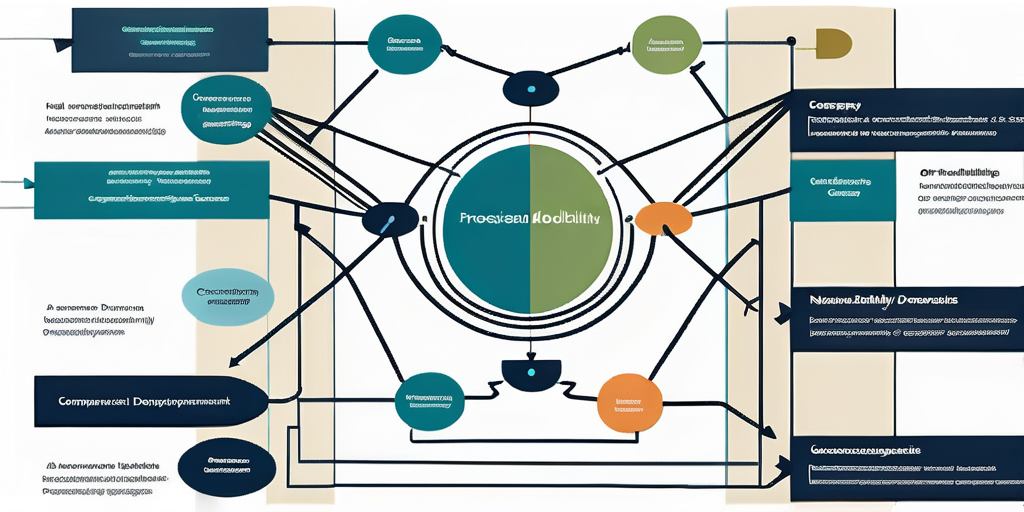In today’s competitive job market, organizations are recognizing the importance of internal mobility as a key strategy for employee development and retention. By creating clear career pathways and offering opportunities for growth within the company, businesses can not only enhance employee satisfaction but also drive innovation and maintain a competitive edge. In this article, we will explore the steps to build an effective internal mobility strategy that can benefit both employees and the organization as a whole.
Understanding the Importance of Internal Mobility Strategy
Internal mobility refers to the movement and progression of employees within a company, whether through promotions, lateral moves, or transfers. A well-structured internal mobility strategy can have a significant impact on employee retention, fostering a sense of loyalty and commitment. By providing employees with opportunities for growth and development, organizations can reduce turnover rates and the associated costs of recruitment and training.
The Role of Internal Mobility in Employee Retention
Employee retention is a critical consideration for any organization. High turnover rates can disrupt workflows, lead to knowledge loss, and have a negative impact on team morale. Implementing an internal mobility strategy allows organizations to retain top talent by offering new challenges and opportunities for professional growth. Employees are more likely to remain engaged and committed to a company that invests in their development.
Benefits of a Well-Structured Internal Mobility Strategy
A well-designed internal mobility strategy can bring numerous benefits to the organization. Firstly, it encourages continuous learning and skills development, enhancing the overall capabilities of the workforce. By providing employees with opportunities to acquire new skills and knowledge, organizations can stay ahead of industry trends and remain competitive in the market.
Secondly, a robust internal mobility strategy fosters a culture of career progression. When employees see a clear path for advancement within the company, they are more motivated to perform at their best and achieve their goals. This not only benefits individual employees but also contributes to the overall success of the organization.
Finally, an effective internal mobility strategy promotes knowledge sharing and cross-functional collaboration. When employees have the opportunity to work in different departments or teams, they gain a broader understanding of the organization as a whole. This exposure to different perspectives and expertise leads to increased innovation and improved problem-solving skills. Employees become more adaptable and versatile, which ultimately benefits the organization’s ability to tackle complex challenges and drive growth.
Laying the Groundwork for Your Internal Mobility Strategy
Building an effective internal mobility strategy requires a solid foundation. It starts with understanding and aligning organizational needs and goals with employees’ skills and aspirations.

But how do you go about identifying these needs and goals? It’s not as simple as just making a list and checking it twice. Developing an internal mobility strategy that truly meets the organization’s needs requires a deep dive into the company’s long-term objectives.
Identifying Organizational Needs and Goals
To develop an internal mobility strategy that meets the organization’s needs, it is crucial to identify current and future skills gaps. This involves evaluating the company’s long-term objectives and identifying the competencies and expertise required to achieve them.
Imagine this: You’re sitting in a boardroom, surrounded by executives, all brainstorming the future of the company. You’re discussing where you want to be in five years, ten years, even twenty years down the line. It’s not just about the bottom line, it’s about the impact you want to make in the world. And to make that impact, you need the right people with the right skills in the right positions.
By conducting thorough talent assessments, organizations can gain insight into their workforce’s strengths and weaknesses, enabling them to target their internal mobility efforts effectively. It’s like putting together a puzzle – you need to know what pieces you have and what pieces you’re missing in order to complete the picture.
Assessing Current Employee Skills and Aspirations
Equally important is assessing employees’ skills and aspirations. Conducting performance evaluations and formal assessments can help identify employees’ strengths, weaknesses, and growth potential.
Picture this: You’re sitting down with each employee, one-on-one, discussing their career goals and aspirations. You’re not just asking about their day-to-day tasks, but about their dreams and ambitions. You’re giving them the opportunity to express themselves and share what they truly want out of their career.
Offering opportunities for employees to express their career goals and aspirations can provide valuable input into your internal mobility strategy. Understanding individual aspirations allows organizations to match internal opportunities with employee interests and aspirations, increasing the chances of a successful transition.
So, as you lay the groundwork for your internal mobility strategy, remember to dig deep. Take the time to understand your organization’s needs and goals, and don’t forget to listen to your employees. By doing so, you’ll be well on your way to creating a strategy that not only benefits the company but also empowers and engages your workforce.
Designing the Internal Mobility Strategy

Once the foundation is laid, it is time to design the internal mobility strategy, focusing on creating clear career pathways and implementing effective training and development programs.
Creating Clear Career Pathways
A well-defined career progression framework outlines the various job roles and positions within the organization, along with the skills and experiences required for each level. By mapping out clear career paths, organizations provide employees with a sense of direction and purpose. This clarity helps employees understand what they need to do to progress and motivates them to continually enhance their skills.
When designing clear career pathways, it is essential to consider the different options available to employees. This includes vertical progression, where employees move up the hierarchical ladder, as well as horizontal progression, where employees can explore different roles within their current level. By offering a range of career pathways, organizations can cater to the diverse aspirations and interests of their employees, ensuring that everyone has an opportunity to grow and develop.
Developing Effective Training and Development Programs
Training and development programs play a vital role in supporting internal mobility. By offering targeted training opportunities, organizations can equip employees with the skills and knowledge necessary to succeed in new roles or positions. These programs can include mentoring, job rotation, cross-functional projects, and leadership development initiatives. Effective development programs not only enhance employees’ capabilities but also promote a learning culture within the organization.
When developing training and development programs, it is crucial to consider the specific needs and aspirations of employees. This can be done through regular performance assessments and discussions to identify areas for improvement and growth. By tailoring training programs to address these needs, organizations can ensure that employees receive the support they require to excel in their careers.
In addition to formal training programs, organizations can also encourage a culture of continuous learning by providing access to resources such as online courses, industry conferences, and professional networking events. By fostering a learning environment, organizations empower employees to take ownership of their development and stay up-to-date with the latest industry trends and best practices.
Implementing the Internal Mobility Strategy
Implementation is a crucial phase of building an internal mobility strategy. Clear communication, transparency, and leveraging technology are essential for a successful implementation.

Communication and Transparency in Implementation
Organizations need to communicate the internal mobility strategy to all employees clearly. This includes explaining the benefits and opportunities available, along with outlining the process for applying and transitioning into new roles. Transparency is key to building employee trust and eliminating any perceived favoritism or bias in the internal mobility process. Regular updates and open channels of communication allow employees to stay informed and engaged throughout the implementation process.
During the implementation phase, it is important for leaders to actively listen to employee feedback and address any concerns or questions that may arise. This two-way communication fosters a sense of inclusivity and ensures that employees feel heard and valued. By creating a culture of open dialogue, organizations can strengthen their internal mobility strategy and drive employee satisfaction.
Leveraging Technology for Efficient Implementation
Utilizing technology can streamline and enhance the implementation of an internal mobility strategy. Automated tools and systems can be used for internal job postings, skills matching, and tracking employee development. Technology can also facilitate knowledge sharing and collaboration, enabling employees to connect and learn from each other across different teams and locations. By leveraging technology, organizations can ensure a seamless and efficient internal mobility process.
Moreover, technology can provide valuable data and analytics that can help organizations measure the effectiveness of their internal mobility strategy. By analyzing metrics such as employee engagement, retention rates, and career progression, organizations can identify areas for improvement and make data-driven decisions to optimize their internal mobility programs. This data-driven approach ensures that the implementation of the strategy is continuously refined and aligned with the evolving needs of the workforce.
Evaluating the Success of Your Internal Mobility Strategy
Regular evaluation and adjustment are necessary to ensure the ongoing success of an internal mobility strategy. But how exactly can organizations evaluate the effectiveness of their internal mobility efforts? Let’s explore some key performance indicators (KPIs) that can help organizations track and measure the impact of their internal mobility strategy.

Key Performance Indicators for Internal Mobility
Identifying and measuring KPIs allows organizations to track the effectiveness of their internal mobility strategy. These KPIs can provide valuable insights into the success of the program and help organizations make data-driven decisions. Here are some important KPIs to consider:
- Internal Promotion Rates: This metric measures the percentage of employees who have been promoted internally. A higher internal promotion rate indicates that the organization is effectively nurturing and developing talent from within.
- Employee Satisfaction and Engagement Levels: By measuring employee satisfaction and engagement levels, organizations can gauge how well their internal mobility strategy is meeting the needs and expectations of their workforce. Higher satisfaction and engagement levels often correlate with a successful internal mobility program.
- Time to Fill Vacancies: This metric measures the time it takes to fill open positions with internal candidates. A shorter time to fill vacancies suggests that the organization has a robust internal talent pool and is effectively leveraging internal mobility.
- Percentage of Employees Participating in Internal Training Programs: This metric measures the percentage of employees who actively participate in internal training programs. A higher participation rate indicates that employees are eager to develop their skills and take advantage of internal growth opportunities.
By monitoring these indicators, organizations can gain valuable insights into the effectiveness of their internal mobility strategy. These metrics can help identify areas for improvement and guide decision-making to ensure the program’s ongoing success.
Regular Review and Strategy Adjustment

A dynamic internal mobility strategy should be regularly reviewed and adjusted to meet changing organizational needs and market conditions. Organizations should not view their internal mobility strategy as a one-time implementation, but rather as an ongoing process of improvement.
One effective way to continuously improve the internal mobility program is by soliciting feedback from employees. Employees are the ones directly experiencing the program, and their insights can provide valuable perspectives on its strengths and areas for improvement. By incorporating employee suggestions and addressing their concerns, organizations can enhance the effectiveness and relevance of their internal mobility strategy.
Regular strategy reviews also allow organizations to adapt quickly to evolving business landscapes. As market conditions change, organizations need to ensure that their internal mobility remains aligned with their overall goals. By regularly reviewing the strategy and making necessary adjustments, organizations can stay ahead of the curve and maintain a competitive edge.
Expanding and refining an internal mobility strategy is an ongoing journey. It requires a commitment to continuous improvement, a willingness to listen to employees, and a proactive approach to adaptability. By investing in their employees’ futures and providing them with opportunities for growth and development, organizations can build a loyal and skilled workforce that drives innovation and secures their competitive advantage.